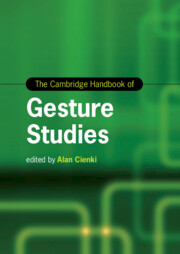Book contents
- The Cambridge Handbook of Gesture Studies
- Cambridge Handbooks in Language and Linguistics
- The Cambridge Handbook of Gesture Studies
- Copyright page
- Contents
- Figures
- Tables
- Contributors
- Introduction
- Part I Gestural Types: Forms and Functions
- Part II Ways of Approaching Gesture Analysis
- 6 Contributions to the Study of Visible Action as Utterance: A Fifty-Year Retrospective
- 7 Systems of Gesture Coding and Annotation
- 8 A Toolbox of Methods for Gesture Analysis
- 9 The Gestural Sign: A Concrete and Reasoned Analysis of Co-Speech Gesture
- 10 Creation and Analysis of the Multimedia Russian Corpus for Gesture Research
- 11 A Kinesiological Approach to Gesture Analysis
- 12 Motion-Tracking Technology for the Study of Gesture
- Part III Gestures and Language
- Part IV Gestures in Relation to Cognition
- Part V Gestures in Relation to Interaction
- Index
- References
7 - Systems of Gesture Coding and Annotation
from Part II - Ways of Approaching Gesture Analysis
Published online by Cambridge University Press: 01 May 2024
- The Cambridge Handbook of Gesture Studies
- Cambridge Handbooks in Language and Linguistics
- The Cambridge Handbook of Gesture Studies
- Copyright page
- Contents
- Figures
- Tables
- Contributors
- Introduction
- Part I Gestural Types: Forms and Functions
- Part II Ways of Approaching Gesture Analysis
- 6 Contributions to the Study of Visible Action as Utterance: A Fifty-Year Retrospective
- 7 Systems of Gesture Coding and Annotation
- 8 A Toolbox of Methods for Gesture Analysis
- 9 The Gestural Sign: A Concrete and Reasoned Analysis of Co-Speech Gesture
- 10 Creation and Analysis of the Multimedia Russian Corpus for Gesture Research
- 11 A Kinesiological Approach to Gesture Analysis
- 12 Motion-Tracking Technology for the Study of Gesture
- Part III Gestures and Language
- Part IV Gestures in Relation to Cognition
- Part V Gestures in Relation to Interaction
- Index
- References
Summary
As there are many different methods of linguistic analysis, there are many different ways of approaching gesture analysis. This chapter gives a selective overview of the current state of art on gesture coding and annotation systems. It opens with a discussion on the difference between coding and annotation, before it considers aims and challenges in gesture coding and annotation. Afterward, the chapter reviews existing systems and reflects on the interrelation between subject, research question, coding and annotation system. The chapter emphasizes that coding and annotations systems are always influenced by the particular theoretical framework in which they are situated. Accordingly, similar to the analysis of language, a theory-neutral analysis of gestures is not possible. Rather, theoretical assumptions influence subjects, aspects and levels of analysis and as such also make themselves visible in annotation systems. This will be illustrated by exemplary research topics in gestures studies: language, language development, cognition, interaction, and human–machine interaction. The account of the individual systems thereby does not aim at an extensive discussion, but rather focuses on their general logic for answering their particular research question. Here, differences between systems addressing the same research topic (e.g. language) as well as differences across research topics (e.g. language vs. interaction) will be explored. The chapter closes with some considerations on possible future developments.
- Type
- Chapter
- Information
- The Cambridge Handbook of Gesture Studies , pp. 158 - 181Publisher: Cambridge University PressPrint publication year: 2024

